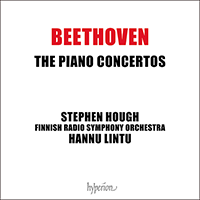Another Beethoven 5 with a possible interpretational issue, though this time not a repeat.

In the May 2020 edition of Gramophone, as part of the article about Stephen Hough's new cycle of Beethoven piano concertos, I was interested to read this.
.....this recording might be the first one on which a modern piano plays the first chord of the concerto. The score had never been published like this before Jonathan Del Mar's Bärenreiter edition of 2015. 'In the manuscript it is written as a figured bass,' Hough explains. 'The first chord in the score is E flat with a figure 5 above it, which just means that you play a root chord in E flat. The '5' — the fifth, the B flat — is missing in the whole of the rest of the orchestra. Only the pianist has it. And no pianists play it. So if you don't play it, you are missing a note that Beethoven expected to be heard. And also, psychologically you need it. Having played it like that, I now cannot imagine not doing it. Beethoven didn't need to put the chord in because no pianist of his time would have dreamt of not playing it.'
Seems a compelling argument to me.
(Sorry if this is old news to all those on the forum who are more Beethoven aware than I am!)

In the May 2020 edition of Gramophone, as part of the article about Stephen Hough's new cycle of Beethoven piano concertos, I was interested to read this.
.....this recording might be the first one on which a modern piano plays the first chord of the concerto. The score had never been published like this before Jonathan Del Mar's Bärenreiter edition of 2015. 'In the manuscript it is written as a figured bass,' Hough explains. 'The first chord in the score is E flat with a figure 5 above it, which just means that you play a root chord in E flat. The '5' — the fifth, the B flat — is missing in the whole of the rest of the orchestra. Only the pianist has it. And no pianists play it. So if you don't play it, you are missing a note that Beethoven expected to be heard. And also, psychologically you need it. Having played it like that, I now cannot imagine not doing it. Beethoven didn't need to put the chord in because no pianist of his time would have dreamt of not playing it.'
Seems a compelling argument to me.
(Sorry if this is old news to all those on the forum who are more Beethoven aware than I am!)


Comment